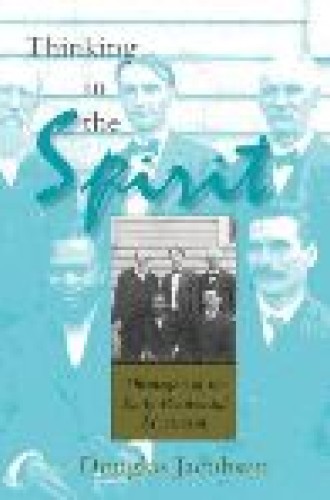Thinking in the Spirit: Theologies of the Early Pentecostal Movement
In June 1918 a Philadelphia reporter asked Pentecostal evangelist Aimee Semple McPherson to describe her theology. McPherson flashed a smile and replied that she had none: rather, she favored old-fashioned experience. She was not alone. Most early Pentecostals explicitly shunned theology, along with the other baggage of “dead” denominations. In general, they preferred action to reflection, the heat of spiritual battle to the life of the mind, spontaneity to order. But their distaste for formal theology could not mask the role of biblicism and informal theology among the rank and file, who recited, invoked and applied obscure passages of the King James Bible to make the point that New Testament spiritual gifts had been restored as a sign of the imminent end of time.
From the outset, despite the noisy disorder of participants whose dislike of religious formalities was second only to their enthusiasm for religious experiences, scholars have traced the outlines of the thought that explained and sustained the movement. Douglas Jacobsen’s solid work takes seriously this informal and often fragmentary thought and uses it to give us an idea of the theologies that provided overarching meaning in early Pentecostalism. Firmly rooted in an impressive array of hard-to-come-by primary sources, Jacobsen’s book is a milestone in the growing scholarship on Pentecostalism, a must-read for any who want to grasp the essence of the Pentecostal movement.
Jacobsen, Distinguished Professor of Church History and Theology at Messiah College, marshals massive evidence to prove that Pentecostals’ brash anti-intellectualism did not diminish the centrality of the biblical text in their faith. He argues that the interplay between text and Spirit functioned to curb extremes. Pentecostals believed they stood squarely on the biblical text—a text directly illumined by the Holy Spirit rather than reasoned out.
Convinced that they were a “sign people”—that their existence heralded the beginning of the end—Pentecostals considered much contemporary theological discourse irrelevant. Something new was happening through the reappearance of something old, and that new wine could not be poured into the wineskins of traditional Protestantism. But some Pentecostals attempted to explain the movement’s bedrock sense of history, time and place—to give it overarching meaning and order. In so doing they became the movement’s first theological voices.
Jacobsen identifies 12 of these authors who were generally more reflective and comprehensive than most. They are northern and southern, denominational and independent, African American and white—and all were male. Jacobsen justifies the omission of women by explaining that no women of the first generation of Pentecostals wrote comparable book-length theological treatises. By concentrating on the work of these 12, he helps us to understand the larger significance for American Christianity of the rise of Pentecostalism.
Although he writes admirable history, Jacobsen’s interest is not so much in the sources and context for Pentecostal thought as in how each author constructed his particular “vision of Pentecostal faith.” This choice, together with the decision to favor the vocabulary of early Pentecostals over conventional theological categories, helps Jacobsen preserve the distinct voices of the men he studies.
The chapter that explores the theological underpinnings of Oneness Pentecostalism is of particular interest. Since Oneness Pentecostals reject orthodox trinitarian theology, other Pentecostals often regard them as less than Pentecostal. Yet their growing global presence indicates that they are not about to disappear. Jacobsen’s examination of the influence of Andrew Urshan, an Iranian immigrant who became the acknowledged leader of the United Pentecostal Church, and G. T. Haywood, the preeminent African-American voice in the Pentecostal Assemblies of the World, integrates Oneness Pentecostals into the story instead of marginalizing them. His observations about the Nestorian context in which Urshan spent his formative years offer tantalizing suggestions, and his sensitivity to nuance combined with his case-study approach enables Jacobsen to offer an unusually rich rendering of what early Oneness Pentecostals believed. The theologies developed by Haywood and Urshan stand as two of the 12 distinct voices that readers engage.
Toward the end of the book, Jacobsen offers a chapter titled “Theology at the Boundaries of the Pentecostal Movement.” Jacobsen’s comments on the blurring at the boundaries—who’s in, who’s out, and why—speak especially to contemporary situations in which the question of Pentecostal identity agitates. What makes someone Pentecostal? The answer is considerably murkier in 2004 than it was in 1906.
To explore the boundaries where insider/outsider identity is difficult to discern, Jacobsen offers case studies of F. F. Bosworth, a onetime Assemblies of God preacher who abandoned Pentecostalism for healing evangelism, and E. W. Kenyon, an evangelist with no formal Pentecostal ties whose thought about faith, prosperity and the use of Jesus’ name has had an enduring influence on Pentecostal theology. Jacobsen demonstrates that those on the edges can deeply impact those for whom Pentecostal identity is clear-cut, and he challenges the view that identity was ever as uncontested as insiders liked to think.
Thinking in the Spirit is not only about the biblical understandings and sense of history that animated early Pentecostals. It is also a study of Pentecostalism’s enduring appeal. Jacobsen attributes this to the Pentecostal blend of spiritual freedom and biblical rootedness. The movement thrives where people value religious experience but are willing to test its limits by a literal reading of scripture.





